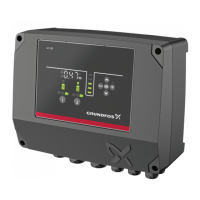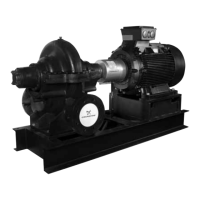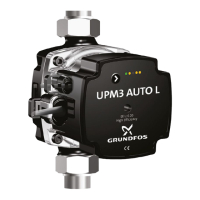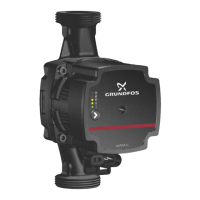7
English (US)
• If possible, run a horizontal inlet line along an even gradient.
We recommend a gradual upward slope to the pump under
suction lift conditions, and a gradual downward slope under
positive inlet pressure conditions.
• Avoid any high points, such as pipe loops (see fig. 3), as this
may create air pockets and throttle the system or cause erratic
pumping.
• Install a gate valve in the inlet line to be able to isolate the
pump during shutdown and maintenance, and to facilitate
pump removal. Where two or more pumps are connected to
the same inlet line, install two gate valves to be able to isolate
each pump from the line.
• Always install gate or butterfly valves in positions that prevent
air pockets.
• During pumping operation, the valves on the inlet line must
always be fully open.
• Install properly sized pressure gauges in the tapped holes on
the pump inlet and outlet flanges.
Pressure gauges will enable the operator to monitor the pump
performance and determine whether the pump conforms to the
parameters of the performance curve. If cavitation, vapor
binding, or other unstable operating situations occur, the
pressure gauges will indicate wide fluctuation in the inlet and
outlet pressures.
Fig. 3 Air pocket prevention
4.4.3 Outlet pipe
• A short outlet pipe can be the same diameter as the pump
outlet port. A long outlet pipe must be one or two sizes larger
than the outlet port, depending on the length.
• It is best to use long horizontal outlet pipes.
• Install a gate valve near the outlet port to be able to isolate the
pump during shutdown and maintenance, and to facilitate
pump removal.
• Any high points in the outlet pipe may entrap air or gas and
thus retard pump operation.
• If water hammer occurs, i.e. if check valves are used, close
the outlet gate valve before pump shutdown.
4.4.4 Shaft seals
The pumps are available with both stuffing boxes with packing
rings and mechanical shaft seals.
Stuffing boxes
The stuffing boxes are normally packed before shipment.
If the pump is installed within 60 days after shipment, the packing
material will be in good condition for operation with a sufficient
supply of lubricating liquid.
If the pump is stored for more than 60 days, it may be necessary
to repack the stuffing boxes.
The stuffing box must be supplied at all times with a source of
clean, clear liquid to flush and lubricate the packing rings.
Packing gland adjustment
With the pump running, adjust the packing gland to permit a
leakage of 40 to 60 drops per minute for shaft lubrication. After
initial startup, additional packing and adjustment may be
required.
Mechanical shaft seals
Mechanical shaft seals require no maintenance or adjustment.
End suction pumps equipped with mechanical shaft seals are
matched to the operating conditions for which the pump was sold.
Observe the following precautions to avoid shaft seal damage
and to obtain maximum shaft seal life:
Clean and purge the inlet pipe in new installations before
installing and operating pump. Pipe scale, welding slag and other
abrasives can cause rapid shaft seal failure.
At no point must the diameter of the inlet pipe be
smaller than that of the pump inlet port.
Do not use globe valves, particularly when NPSH is
critical.
TM05 4792 2613
Do not run the pump dry or against a closed valve.
Dry running will cause shaft seal failure within
minutes.
Do not exceed the temperature or pressure
limitations for the mechanical shaft seal used.
LC_LCV_LF_LCS_1 language_US Eng.book Page 7 Thursday, August 24, 2017 4:08 PM
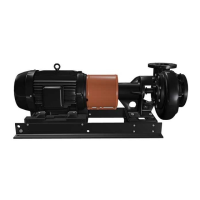
